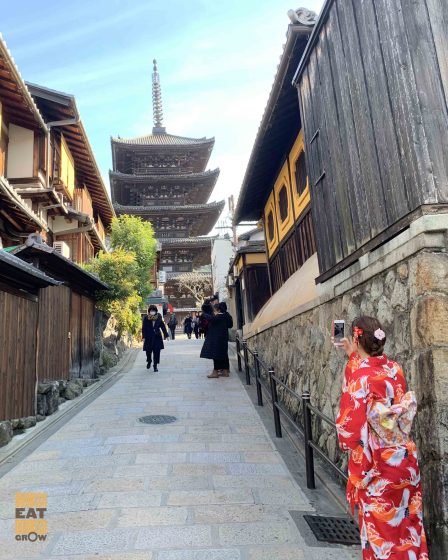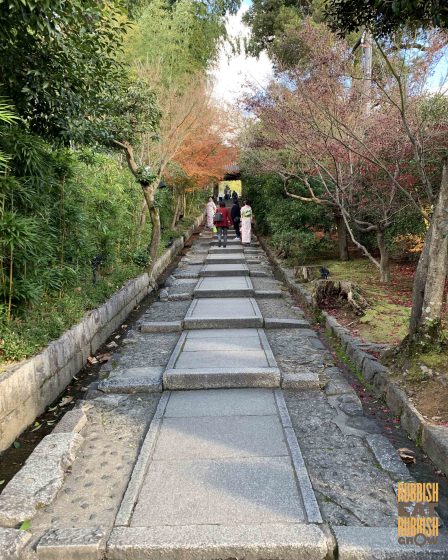Before you arrive at Days 7 & 8 of Osaka-Kyoto Itinerary, you may want some other information:
Osaka, Kyoto, Nara, Kobe Itinerary: Pre-planning
Osaka-Kyoto Itinerary: Day 1 (Arrival) and Day 2, Day Trip to Kobe
Osaka-Kyoto Itinerary Days 3 & 4: Ohara Onsen Ryokan and Sanzen-in Temple
Osaka-Kyoto Itinerary Days 5 & 6: Kinkakuji, Kyoto Imperial Palace, and Arashiyama Bamboo Forest
The path to Yasaka-no-Tou pagoda is scenic.
DAY 7
9am – Take a bus to Higashiyama District where there are countless temples. Please do NOT attempt to see them all. Just shortlist the unique temples you want to see. Be prepared to walk, wear proper sports shoes for walking.
Higashiyama District is one of the best places to catch a glimpse of geishas. But they only work at nights. In daytime, it’s tourists pretending to be geishas. If you see a real geisha, make sure to ask for permission to take photo.
This walking route will take about 5 hours although there is a break in between. First, after you alight, go to Kodaiji temple, which was established in 1606. The unique feature here is the rock garden.
Then walk through Ishibe Alley, just outside Kodaiji. It’s a picturesque alley, featured in many films.
Walk towards Yasaka-no-Tou pagoda (¥400, opens at 10am), which was built in 592. That’s right, there is no “1” in front from 592! While most pagodas are situated in temples, this one stands alone since the temple was burnt down. By the way, you can only go up to level 2 of the pagoda. So it may not be worth paying the admission fee. You want just want to look at it and take some photos for memory.
Yasaka-no-Tou pagoda and a yuzu tree that bears fruits.
10am – Have breakfast at Starbucks Coffee Kyoto Ninenzaka Yasaka Chaya. It’s the first Starbucks located in a traditional Japanese house, complete with tatami mats. It took 10 years of planning to opening. Also: I know Starbucks is a global American chain but really, the food at Starbucks in Kyoto is awesomest.
The first Starbucks with tatami.
Within the Starbucks, there is a garden. And in the garden, there is a tsukubai, a washbasin which is used for visitors to cleanse and purify themselves before visiting a temple or before attending a tea ceremony.
Matcha is one of the 10 food to eat in Kyoto. We drank it everywhere we go.
10.45am -Explore Ninenzaka, the street along Starbucks, and walk towards Sannenzaka. These two streets, Ninenzaka and Sannenzaka, are lined beautifully restored traditional shophouses. They are also quite commericalised, so if you want to buy any souvenirs here, go here and shop.
Ninenzaka is a gentle sloping street with traditional Japanese houses.
12pm – At the end of Sannensaka is Kiyomizu Dera which literally means “Pure Water Temple,” best known for its wooden stage that juts out from its main hall. It was founded in 780. This is probably the most visited attraction in Kyoto so be prepared to squeeze a little.
I didn’t include Kitano Tenmangu Shrine in this itinerary but if you have free time, you should go. It’s free and there are interactive elements.
The tori gates at kitano tenmangu shrine.
First interactive element at Kitano Tenmangu Shrine: in this tiny hut, the deity Nene is revered. If you walk around the hut three times, your wish will come true.
Second interactive element: the mani wheels. Walk about the hall and turn the wheels clockwise with your right hand, your wish will come true.
Third element: the tenmangu ox. Oxen are messengers of Tenjin-sama, a Shinto deity. If you’ve an ailment on your body, touch the corresponding area on the ox with your right hand or both hands. The ox will bear your suffering for you.
1.30pm – Lunch. We ate at Yuba Ryori Higashiyama Yuuzu, which was an amazing experience. Highly recommended. But don’t eat too much because we will be having…
Kiyomizu Dera, one of the most popular attractions in Kyoto.
3pm – TEA! After a vigorous morning, it’s best to sit around and not tire yourselves too much. Tea is a must-do experience in Kyoto because wagashi (Japanese sweets) originated in Kyoto and the teahouses go all the way back to 1700s. This is a list of popular teahouses to choose from.
5pm – Go back to hotel and rest and enjoy the facilities.
7pm – Dinner. Check out our food recommendations.
Nijo Castle – spartan and austere
DAY 8
10am – Visit Nijo Castle, built in 1603 (English tour starts at 10am and 12pm, lasting an hour, ¥1000). It’s interesting to juxtapose the architecture of Kyoto Imperial Palace (we visited it on Day 6) with Nijo Castle: one was for royalty, the other is the residence of Tokugawa Ieyasu, the first shogun of the Edo Period (1603-1867). You can see the sparseness at Nijo, compared with the opulence at the Imperial Palace.
Nijo castle – garden
12pm – Yamazaki is my favoritest whiskey so it is a must-visit to the distillery. You have to make reservations if you want a guided tour around the premises (which is in Japanese, no English tours). Otherwise, you can walk around the museum yourself.
It’s a short 25-minute train ride from Kyoto Station to Yamazaki Distillery established in 1923. When you arrive at Oyamazaki Station, there is bus-stop there going to “Asahi Beer Oyamazaki Villa Museum of Art.” Do NOT take the bus. It goes to another place with a similar name, not the distillery.
Lunch here. Just across from Oyamazaki station, there is a lovely and cosy cafe called Cafe Tabi Tabi. You can’t miss it. The food is tasty and the service is wonderful.
Cafe Tabi Tabi is a quaint cafe just opposite the entrance of Oyamazaki Station.
Beautiful and delicious food.
After lunch, take a short 5-minute walk to the distillery. Just follow your google map.
Yamazaki distillery
At the distillery, after your tour and shopping at its souvenir shop, you may also taste their whiskeys. Unfortunately, unlike the Nikka distillery at Hokkaido which serves free samples, Yamazaki charges for their whiskeys.
You can purchase their whiskeys in individual shots or in a set. The shots cost as low as ¥100. I recommend the Long Matured whiskey set (¥1800), which has Yamazaki 18 years old, Hakushu 18 years old, and Hibiki 21 years old.
Since we were here, I also recommend trying the Yamazaki 25 years old (¥2900 / S$37). I know, it’s super expensive for one shot but one bottle goes for ¥900000 / S$11500 and since I will never in my life buy a bottle, I will settle for a shot.
From left to right: Hibiki 21, Hakushu 18, Yamazaki 18, and Yamazaki 25.
What is different about Yamazaki whiskey is that the founder wanted a Japanese whiskey, and not a whiskey that is an imitation of Scottish whiskey. These are the notes I took:
Yamazaki 18
Piercing on tongue only, not in throat or chest
Plum sweetness, smoky, spicy
Not dry
Hakushu 18
More yellowish than brownish
Mild scent
Oily, creamy like blue cheese
No burning sensation
Long finish
Hibiki 21
Tip and Side of tongue experience sweetness
Vanilla
Yamasaki 25
Colour of red tea
Dry, sweet and smooth, not oily
No burning sensation anywhere
4pm – Return to Kyoto. Free and easy.
The next day, we will return to Osaka.
You may be interested in…
–5 Must Eat Food in Osaka and Where to Find Them
–Teuchisoba Kanei 手打ち蕎麦 かね井, Kyoto: Worst Experience in Japan
–Where to Stay in Kyoto, Japan: Hotel Vischio Kyoto Review
–Shigetsu, Kyoto: Inside Tenryuji Temple, Zen Buddhist Cuisine Is The Best Food We Ate in Kyoto
Written by Dr. A. Nathanael Ho.






















